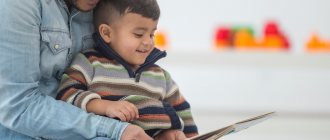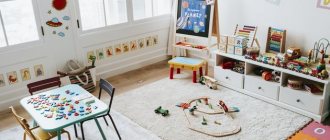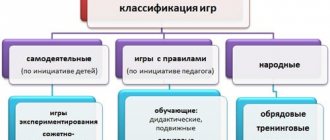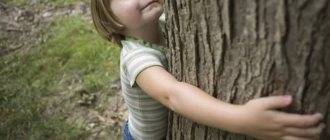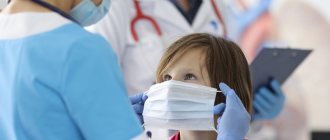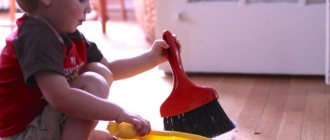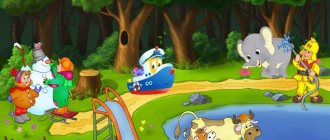Types of forms of education for preschool children
The form of education, as part of the pedagogical process, depends on the goals, content and methods, while simultaneously determining their implementation in specific activities.
Finished works on a similar topic
Course work Forms of training and education of preschool children 470 ₽ Abstract Forms of training and education of preschool children 240 ₽ Examination Forms of training and education of preschool children 220 ₽
Receive completed work or specialist advice on your educational project Find out the cost
Based on this, the forms of education largely depend on specific pedagogical situations, and therefore they are very diverse, creative in nature and often individually unique.
Despite the uniqueness and individuality, it is customary to classify the forms of education of preschool children on a number of grounds.
Forms of education of preschool children depending on the number of participants in the process:
- Individual - carried out in the form of conversations, individual lessons of one student with a teacher, etc.
- Group – represent the educational work of a teacher with a group of students, within a circle, temporary group, etc.
- Mass - held in the form of holidays, rallies, processions, etc., in which several different age groups, the entire kindergarten or nearby preschool educational institutions take part.
Forms of education of preschool children depending on the main type of activity:
- forms of cognitive activity;
- forms of labor and socially useful activities;
- forms of aesthetic activity;
- physical culture and health-improving form of activity;
- value-oriented form of activity.
Forms of education depending on the method of educational influence on the child (author N. I. Boldyrev):
- Verbal forms - represent lines, conferences, meetings, gatherings, meetings, etc.
- Practical forms - represented by excursions, Olympiads, sports days, competitions, cleanup days, etc.
- Visual forms include visiting museums and exhibitions; creation of information stands on various topics, wall newspapers, etc.
Note 2
Thus, the forms of education of preschool children are divided depending on the method of educational influence, time and frequency, as well as on the number of participants.
Interactive methods of teaching and developing speech for preschoolers
Microphone is a method of work during which children, together with the teacher, form a circle and, passing an imitated or toy microphone to each other, express their thoughts on a given topic.
For example, a child takes a microphone, talks about himself in a few sentences, and passes the microphone to another child.
All statements made by children are accepted and approved, but not discussed.
Debate is a method of work during which children stand in a circle, express their thoughts on a given topic, passing the microphone to each other, but the statements are discussed: children ask each other questions, answer them, looking for a way to solve the problem.
(For example, Seryozha is in a bad mood, so the children suggest ways to cheer up or eliminate the problem that affected the boy’s mood).
Together - a method of work during which children form working pairs and complete the proposed task, for example, take turns describing a picture.
Chaining is a method of working in which children discuss tasks and make suggestions in a simulated chain. For example, they compose a fairy tale according to a table in which the course of the future fairy tale is presented in drawings or in symbols.
Another option for using this method: the first child names an object, the second - its property, the third - an object with the same properties.
For example, carrots - carrots are sweet - sugar is sweet - sugar is white - snow is white... etc.
Snowball is a method of work during which children unite in small groups and discuss a problematic issue or complete a common task, agreeing on a clear sequence of actions for each group member.
For example, they are building a house, where they agree in advance on the order of actions of each team member and on the color with which this or that child will work.
Synthesis of thoughts is a method of work in which children are united in small groups to complete a specific task, for example, drawing on a piece of paper.
When one group draws, it passes the drawing to another group, whose members finalize the completed task. Upon completion of the work, they write a general story about what they completed and why.
Circle of ideas - interactive teaching methods, when each child or each group performs one task, for example, composing a fairy tale in a new way, discussing it, then making suggestions or ideas (for example, how can we finish the fairy tale so that Kolobok remains alive; how to help Kolobok outwit the fox and the like).
A common project is a method of work during which children are united into several groups (3-4).
Groups are given different tasks, each aimed at solving a different aspect of one problem, for example, drawing their favorite winter activities and talking about them.
Each group presents its “project” - the collective work “Winter Fun” and discusses it together.
Associative flower is a method of work in which children are united in several groups to solve a common problem: the “middle” of a flower with the image of a certain concept is fixed on the board, for example, “toys”, “flowers”, “fruits”, “animals”.
Each group selects association words or association pictures that are pasted around this concept. The team that creates the largest flower (with the largest number of selected association pictures or association words) wins.
“Decision tree” is a method of work that includes several stages:
- Choosing a problem that does not have a clear solution, for example, “What does a tree need to be happy?”
- Consideration of a diagram in which the rectangle is the “trunk” (which denotes this problem), the straight lines are the “branches” (the ways to solve it), and the circles are the “leaves” (the solution to the problem).
- Problem solving: children in subgroups agree, discuss and draw, for example, a butterfly, a bird, etc., placing them on a “decision tree” and explaining their choice.
The method of multichannel activity is a method of working with children, during which various analyzers are necessarily used: vision, hearing, touch, taste, smell.
For example, when viewing a painting, it is advisable to use the following sequence: highlighting the objects depicted in the painting; representation of objects through perception by various analyzers.
After considering all the objects depicted in the picture, it is worth setting the children creative tasks:
- “listen” to the sounds of the picture through “headphones”;
- conduct virtual dialogues on behalf of the depicted characters;
- feel the “aroma” of the flowers depicted in the picture;
- “go beyond what is depicted”;
- mentally touch the picture, determine what its surface is (warm, cold), what the weather is like (windy, rainy, sunny, hot, frosty) and the like.
For example, when looking at the painting “A Walk in the Woods,” you might want to ask the following questions: What do you think the girls are talking about? Look at the bark of the trees, what is it like?
Listen to the sounds of leaves rustling, magpie chirping, etc.
Discussion is a method of collective discussion of a complex issue. All participants in the educational process prepare for the discussion; all children are actively involved.
“Discussion” in English is something that is subject to discussion or debate.
At the end of the discussion, a single collective solution to a problem, problem or recommendation is formulated. No more than five questions (tasks) should be proposed.
They should be formulated in such a way that it is possible to express different views regarding the problem raised.
Children learn to express their own opinions: “I think...”, “I believe...”, “In my opinion...”, “I agree, but...”, “I disagree because...”.
“Brain attack (brainstorming)” is one of the methods that promotes the development of creativity in both children and adults. This method is convenient to use when discussing complex problems or issues.
Time is given for individual reflection on the problem (it can even be up to 10 minutes), and after some time additional information is collected regarding decision-making.
Children participating in a brainstorming session must express all possible (and logically impossible) options for solving a problem, which must be listened to and the only correct decision made.
Quiz is a method-cognitive game that consists of speech tasks and answers to topics from various branches of knowledge. It expands the general cognitive and speech development of children. Questions are selected taking into account the age, program requirements and level of knowledge of the children.
Conversation-dialogue is a method aimed at the participation of children with the speaker. During the lesson, with the presentation of knowledge and consolidation of the material, the teacher poses accompanying questions to the children in order to check their understanding of the information presented.
Modeling problem situations is a method of interaction between adults and children to solve a problem. The situation is specifically modeled by the teacher.
"What? Where? When?" - an active method, during the use of which cooperation, creative problem solving, mutual exchange of opinions, personal knowledge and skills, etc. predominate.
“Pros and cons” is a method of working with children, during which children are asked to solve a problem from two sides: pros and cons. For example, the task is to tell why you like winter (the argument is “for”) and why you don’t like winter (the argument is “against”).
Foresight is a method of working with children, during which it is proposed to “predict” possible solutions to a problem.
For example, invite children to name all the autumn months and talk about what they expect from each month. Later, imagine yourself in the place of one of the months and tell about your predictions: “I am the first month of autumn - September. I am a very warm month. All the children love me because they are starting to go to school...”
The next child continues to talk about this very month (work in pairs).
Showing off is a method of work in which children are asked to divide into teams, each of which thinks of a word and, using non-verbal means, presents this word to the other team, which must guess it.
“What would happen if...?” - a method of work in which children are invited to think and express their assumptions, for example: “What would happen if all the trees on Earth disappeared?”, “What would happen if predatory animals in fairy tales became vegetarians?” etc.
Imaginary picture is a method of work in which children are asked to stand in a circle and each child takes turns describing an imaginary picture (the first child is given a blank sheet of paper with a picture drawn, then he passes the sheet with the mental picture to another participant in the game, and he continues the mental description ).
“What can you do...?” - a method of work during which children learn to understand the multifunctional properties of objects. For example: “Imagine another way to use a pencil? (like a pointer, baton, thermometer, baton, etc.).
Reincarnation is an interactive teaching method when children are invited to divide into teams and imagine themselves in the place of some object (book, pen, table, doll, etc.) and present themselves from the point of view of the chosen role.
A reverse fairy tale is a method of work in which children are asked to divide into two teams and compose their fairy tale differently, replacing basic concepts with opposite ones. Each team receives a task: composes its own fairy tale and guesses the fairy tale of the other team, composed differently.
Example: “Once upon a time there lived a grandfather and a woman. And they had a dog, Zhuk. And the Beetle brought them a bone, not a simple one, but a sugar one. Baba cooked it, cooked it, and didn’t cook it. Grandfather cooked and cooked and did not cook. The cat jumped, overturned the pot, took the bone and carried it away. The grandfather laughs, the woman laughs, and the Beetle barks cheerfully: “I’ll bring you another bone, but not a sugar one, but a plain one, so that it can be cooked quickly.”
Collage is a method of work in which children are asked to divide into two teams and complete their picture (for example, an irregularly shaped figure) on a piece of paper with all available materials and talk about it in 2-3 sentences.
- a method of work during which children are asked to divide into two teams, each of which chooses any object and tries to name all its positive qualities and functions that will help attract the attention of others to it.
Other interactive teaching methods
In addition to the above-mentioned interactive methods of teaching preschoolers, the following are actively used in practice: creative tasks, work in small groups, educational games (role-playing and business games, simulation games, competition games (senior preschool age), intellectual warm-ups, work with visual videos and audio materials, thematic dialogues, analysis of life situations and the like.
Thus, interactive learning in classes (including integrated ones) takes place: in pairs (2 children), in microgroups (3-4 children), in small groups (5-6 children) together with the teacher.
When evaluating children’s statements, you should not use the word “correct”, but say: “interesting”, “unusual”, “good”, “wonderful”, “original”, which stimulates children to make further statements.
Worth remembering! When a preschool child sits politely on a chair, looks at you and just listens, he is not learning.
Interactive technologies in teaching preschoolers
Interactive technology means to interact, communicate with someone; This is a special form of organizing cognitive and communicative activities in which all participants are covered by communication (everyone freely interacts with everyone else, participates in an equal discussion of the problem).
Interactivity develops responsibility and self-criticism in a child, develops a creative approach to solving problems, teaches him to correctly and adequately assess his strengths, and see “blank spots” in his knowledge. The main element of an interactive lesson is dialogue.
During interactive learning, children actively communicate, argue, disagree with the interlocutor, and prove their opinion.
One of the main conditions for conducting classes in preschool educational institutions is the use of interactive teaching methods, activating the mental activity of children at all stages of the lesson.
Insufficient use of interactive methods
Unfortunately, interactive teaching methods are not yet used enough in working with preschoolers. There are some reasons for this (according to A. Kononko):
- the habit of many educators to use explanatory, illustrative, monological methods in their work, to show conformism, to unquestioningly obey the requirements and principles of others;
- distrust of a certain part of teachers towards innovative dialogue methods and their fears;
- lack of experience in their effective use, active self-determination, making responsible decisions, providing advantages to someone (something);
- fear of looking like a “black sheep” in the eyes of others, funny, helpless, inept;
- low self-esteem, excessive anxiety of teachers;
- tendency to be overly critical;
- inability to quickly switch and adapt to new conditions and requirements;
- lack of formation of pedagogical reflection, the ability to objectively evaluate oneself, to correlate one’s capabilities and desires with the requirements of the time.
The need to introduce interactive methods into the educational process is obvious, because:
- today, more than ever, the requirements for updating preschool education for pupils are increasing;
- differentiation and individualization of education for preschool children occurs;
- The requirements for the quality of preschool education are changing, its assessment is not only based on the level of knowledge readiness, but also the elementary life competence of preschool educational institution graduates, their ability to apply knowledge in their own lives, constantly update and enrich it.
Interactive methods of teaching and interacting with children
Interactive teaching methods are ways of targeted interaction between adults and children that provide optimal conditions for their development.
Interactive learning for preschoolers is a specific form of organizing educational activities, the purpose of which is to provide comfortable conditions for interaction in which each child feels his success and, by performing certain intellectual work, achieves high productivity.
Interactive teaching methods provide such learning that enables children in pairs, microgroups or small groups to work through educational material, talking, arguing and discussing different points of view.

